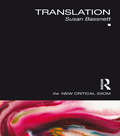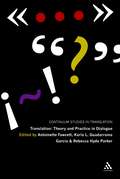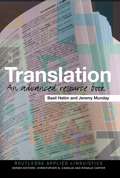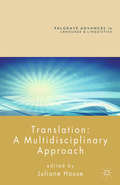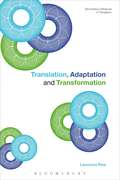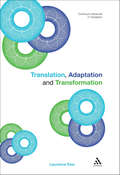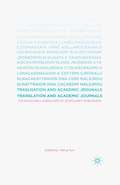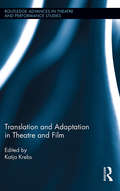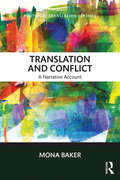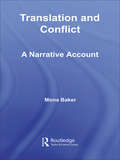- Table View
- List View
Translation (The New Critical Idiom)
by Susan BassnettIn a time when millions travel around the planet; some by choice, some driven by economic or political exile, translation of the written and spoken word is of ever increasing importance. This guide presents readers with an accessible and engaging introduction to the valuable position translation holds within literature and society. Leading translation theorist, Susan Bassnett traces the history of translation, examining the ways translation is currently utilised as a burgeoning interdisciplinary activity and considers more recent research into developing technologies and new media forms. Translation displays the importance of translation across disciplines, and is essential reading for students and scholars of translation, literary studies, globalisation studies, and ancient and modern languages.
Translation: A Guide To The Practice Of Crafting Target Texts
by Stella Cragie Ann PattisonThis practical guide by two experienced translators and translation tutors explores aspects of time, context and culture in a range of translated literary texts, including novels, memoirs, poems and plays. Reflective analytical sections are complemented by a variety of practical tasks that reflect the book’s craft-based approach. Providing a dual focus on both analysis and creativity, this volume helps readers to develop two different skill sets required for translation: deconstruction and reconstruction. To learn how to analyse or deconstruct a source text (ST), the tasks include translating and editing, comparison and analysis of source language (SL) texts and translations, and critiquing or improving target language (TL) texts produced by translators from different times. A range of creative writing challenges reveal the secrets writers use to hook their readers. Whatever language readers translate into, these insights will help them to find their own writer’s voice, making them better equipped to recreate another author’s voice, whatever the time or cultural context. This is the essential guide to improving target texts for all translators and students of translation.
Translation: Translation: Theory And Practice In Dialogue (Continuum Studies in Translation)
by Antoinette Fawcett Karla L. Guadarrama García Rebecca Hyde ParkerThis exciting new book explores the present relevance of translation theory to practice. A range of perspectives provides both current theoretical insights into the relevance of theory to translation and also offers first-hand experiences of applying appropriate strategies and methods to the practice and description of translation. The individual chapters in the book explore theoretical pronouncements and practical observations grouped in topics that include theory and creativity, translation and its relation with linguistics, gender issues and more. The book features four parts: it firstly deals with how theories from both within translation studies and from other disciplines can contribute to our understanding of the practice of translation; secondly, how theory can be reconceptualized from examining translation in practice; thirdly reconceptualizing practice from theory; and finally Eastern European and Asian perspectives of how translation theory and practice inform one another. The chapters all show examples from theoretical and practical as well as pedagogical issues ensuring appeal for a wide readership. This book will appeal to advanced level students, researchers and academics in translation studies.
Translation: An Advanced Resource Book (PDF)
by Basil Hatim Jeremy MundayRoutledge Applied Linguistics is a series of comprehensive textbooks, providing students and researchers with the support they need for advanced study in the core areas of English language and Applied Linguistics. Each book in the series guides readers through three main sections, enabling them to explore and develop major themes within the discipline. Section A, Introduction, establishes the key terms and concepts and extends readers’ techniques of analysis through practical application. Section B, Extension, brings together influential articles, sets them in context, and discusses their contribution to the field. Section C, Exploration, builds on knowledge gained in the first two sections, setting thoughtful tasks around further illustrative material. This enables readers to engage more actively with the subject matter and encourages them to develop their own research responses. Throughout the book, topics are revisited, extended, interwoven and deconstructed, with the reader’s understanding strengthened by tasks and follow-up questions. Translation: examines the theory and practice of translation from a variety of linguistic and cultural angles, including semantics, functional linguistics, corpus and cognitive linguistics, discourse analysis, gender studies and postcolonialism draws on a wide range of languages, including French, Spanish, German, Italian, Russian and Arabic explores material from a variety of sources, such as the Internet, advertisements, religious texts, literary and technical texts gathers together influential readings from the key names in the discipline, including James S. Holmes, George Steiner, Vinay and Darbelnet, Eugene Nida, Werner Koller and Ernst-August Gutt. Written by experienced teachers and researchers in the field, Translation: An Advanced Resource Book is an essential textbook for students and researchers of English language and Applied Linguistics. The accompanying website to this book can be found at http://www.routledge.com/textbooks/041528306X
Translation: An advanced resource book for students (Routledge Applied Linguistics)
by Basil Hatim Jeremy MundayTranslation, Second Edition introduces the theory and practice of translation from a variety of linguistic and cultural angles, and has been revised and updated to feature: a study of translation through the lens of key topics in linguistics such as semantics, functional linguistics, corpus and cognitive linguistics, discourse analysis, gender studies and postcolonialism; a wide range of examples from other languages, including French, Spanish, German, Italian, Russian and Arabic, with English back-translations to assist comprehension; material from a variety of sources, genres and text-types, such as advertisements, religious texts, reports for international organizations, videogames, literary and technical texts; influential readings from the key names in the discipline, including Jean-Paul Vinay and Jean Darbelnet, Eugene Nida, Werner Koller and Ernst-August Gutt, and contains new readings from Mona Baker, Michael Cronin, Kim Grego, Miguel A. Jiménez-Crespo, Kevin Gary Smith, Harald Martin Olk, Carmen Mangiron and Minako O’Hagan. Additional resources for the book can be found at www.routledge.com/9780415536141. Written by two experienced teachers, translators and researchers, Translation remains an essential resource for students and researchers of translation studies and Applied Linguistics.
Translation: An advanced resource book for students (Routledge Applied Linguistics)
by Basil Hatim Jeremy MundayTranslation, Second Edition introduces the theory and practice of translation from a variety of linguistic and cultural angles, and has been revised and updated to feature: a study of translation through the lens of key topics in linguistics such as semantics, functional linguistics, corpus and cognitive linguistics, discourse analysis, gender studies and postcolonialism; a wide range of examples from other languages, including French, Spanish, German, Italian, Russian and Arabic, with English back-translations to assist comprehension; material from a variety of sources, genres and text-types, such as advertisements, religious texts, reports for international organizations, videogames, literary and technical texts; influential readings from the key names in the discipline, including Jean-Paul Vinay and Jean Darbelnet, Eugene Nida, Werner Koller and Ernst-August Gutt, and contains new readings from Mona Baker, Michael Cronin, Kim Grego, Miguel A. Jiménez-Crespo, Kevin Gary Smith, Harald Martin Olk, Carmen Mangiron and Minako O’Hagan. Additional resources for the book can be found at www.routledge.com/9780415536141. Written by two experienced teachers, translators and researchers, Translation remains an essential resource for students and researchers of translation studies and Applied Linguistics.
Translation: A Multidisciplinary Approach (Palgrave Advances in Language and Linguistics)
by Juliane HouseThe cross-linguistic and cross-cultural practice of translation is a field of rapidly growing international importance. World-renowned experts offer new and multidisciplinary insights on this subject, viewing translation as social action and intercultural communication, and as a phenomenon of languages in contact and a socio-cognitive process.
Translation: A Multidisciplinary Approach (The Basics)
by Juliane HouseTranslation: The Basics is an accessible and comprehensive introduction to the study of translation. Combining traditional text-based views with the context of translation in its widest sense, it presents an integrated approach to methodology in order to critically address influences such as power and gender, as well as cultural, ethical, political and ideological issues. Answering such questions as: How can translations be approached? Do social issues and culture play a part in translations? How does a translation relate to the original work? What effect has globalization had on translation? What are the core concerns of professional translators? Key theoretical issues are explained with reference to a range of case studies, suggestions for further reading and a detailed glossary of terms, making this the essential guide for anyone studying translation and translation studies.
Translation: The Interpretive Model
by Marianne LedererThis book, the English version of La traduction aujourd'hui (Hachette 1994), describes the interpretive theory of translation developed at the Paris Ecole Supérieure d'Interprètes et de Traducteurs (ESIT) over the last 35 years. The theory identifies the mental and cognitive processes involved in both oral and written translation: understanding the text, deverbalizing its language, re-expressing sense. For the purposes of translation, languages are a means of transmitting sense, they are not to be translated as such. Although translation involves the use of correspondences, translators generally set up equivalence between text segments. The synecdochic nature of both languages and texts, a phenomenon discussed in the book, explains why translation is possible across language differences. The many practical problems faced by translators, the difference between translation exercises used as a language teaching tool and professional translation, translating into a foreign language, and machine translation as compared to human translation are also discussed.
Translation: The Interpretive Model
by Marianne LedererThis book, the English version of La traduction aujourd'hui (Hachette 1994), describes the interpretive theory of translation developed at the Paris Ecole Supérieure d'Interprètes et de Traducteurs (ESIT) over the last 35 years. The theory identifies the mental and cognitive processes involved in both oral and written translation: understanding the text, deverbalizing its language, re-expressing sense. For the purposes of translation, languages are a means of transmitting sense, they are not to be translated as such. Although translation involves the use of correspondences, translators generally set up equivalence between text segments. The synecdochic nature of both languages and texts, a phenomenon discussed in the book, explains why translation is possible across language differences. The many practical problems faced by translators, the difference between translation exercises used as a language teaching tool and professional translation, translating into a foreign language, and machine translation as compared to human translation are also discussed.
Translation, Adaptation and Digital Media (Translation Practices Explained)
by John Milton Silvia CobeloAdaptation has always been central to Translation Studies, and, as print media becomes less and less dominant, and new media become central to communication, Adaptation is more than ever a vital area of Translation and Translation Studies. In addition, links to new digital media are examined. This is the only user-friendly textbook covering the full area of Translation, Adaptation, and Digital Media applicable to any language combination. Divided into nine chapters, it includes a wide range of texts from Brazilian culture, ensuring an ex-centric view of translation. Each chapter contains an expository section, case studies, and student activities to support learning. It emphasises the central role of Adaptation in the translation of works for the popular book market, for theatre, cinema, radio, and, especially, the new media. This is the essential textbook for students in Translation and Adaptation Studies courses and instructors and professionals working on adaptation and transmedia projects.
Translation, Adaptation and Digital Media (Translation Practices Explained)
by John Milton Silvia CobeloAdaptation has always been central to Translation Studies, and, as print media becomes less and less dominant, and new media become central to communication, Adaptation is more than ever a vital area of Translation and Translation Studies. In addition, links to new digital media are examined. This is the only user-friendly textbook covering the full area of Translation, Adaptation, and Digital Media applicable to any language combination. Divided into nine chapters, it includes a wide range of texts from Brazilian culture, ensuring an ex-centric view of translation. Each chapter contains an expository section, case studies, and student activities to support learning. It emphasises the central role of Adaptation in the translation of works for the popular book market, for theatre, cinema, radio, and, especially, the new media. This is the essential textbook for students in Translation and Adaptation Studies courses and instructors and professionals working on adaptation and transmedia projects.
Translation, Adaptation and Transformation (Continuum Advances in Translation)
by Laurence RawIn recent years adaptation studies has established itself as a discipline in its own right, separate from translation studies. The bulk of its activity to date has been restricted to literature and film departments, focussing on questions of textual transfer and adaptation of text to film. It is however, much more interdisciplinary, and is not simply a case of transferring content from one medium to another. This collection furthers the research into exactly what the act of adaptation involves and whether it differs from other acts of textual rewriting. In addition, the 'cultural turn' in translation studies has prompted many scholars to consider adaptation as a form of inter-semiotic translation. But what does this mean, and how can we best theorize it? What are the semiotic systems that underlie translation and adaptation? Containing theoretical chapters and personal accounts of actual adaptions and translations, this is an original contribution to translation and adaptation studies which will appeal to researchers and graduate students.
Translation, Adaptation and Transformation (Continuum Advances in Translation #8)
by Laurence RawIn recent years adaptation studies has established itself as a discipline in its own right, separate from translation studies. The bulk of its activity to date has been restricted to literature and film departments, focussing on questions of textual transfer and adaptation of text to film. It is however, much more interdisciplinary, and is not simply a case of transferring content from one medium to another. This collection furthers the research into exactly what the act of adaptation involves and whether it differs from other acts of textual rewriting. In addition, the 'cultural turn' in translation studies has prompted many scholars to consider adaptation as a form of inter-semiotic translation. But what does this mean, and how can we best theorize it? What are the semiotic systems that underlie translation and adaptation? Containing theoretical chapters and personal accounts of actual adaptions and translations, this is an original contribution to translation and adaptation studies which will appeal to researchers and graduate students.
Translation after Wittgenstein (Translation Theories Explored)
by Philip WilsonIn this eminently readable study, Philip Wilson explores the later writings of Ludwig Wittgenstein and shows how a reading of this philosophy can enable the translation theorist and the practising translator to reflect upon and improve the phenomenon of translation. Wittgenstein, whilst a key figure in twentieth-century philosophy, remains peripheral to the field of translation studies and Wilson argues that his later work, because it deals with the nature of language and meaning, is potentially of great significance and an awareness of this can change translation, both literary and non-literary. Wittgenstein’s life and thought is treated in the introduction, where it is shown how his methods can be applied to areas outside philosophy. The central three chapters of the book survey: the reading of the source text for translation; the writing of the target text; the theorisation of the target text. The author demonstrates how tools from Wittgenstein’s work can be of use in translation studies: the notion of the language-game, for example, helps us to understand meaning by looking at the way that words are used, and this can both help us describe translation and suggest ways of translating. A wide variety of examples and case studies is given throughout the book, from both literary and non-literary sources. Aimed at translation studies scholars, graduate students and researchers, this interdisciplinary book will also be of interest to scholars of philosophy and literature.
Translation after Wittgenstein (Translation Theories Explored)
by Philip WilsonIn this eminently readable study, Philip Wilson explores the later writings of Ludwig Wittgenstein and shows how a reading of this philosophy can enable the translation theorist and the practising translator to reflect upon and improve the phenomenon of translation. Wittgenstein, whilst a key figure in twentieth-century philosophy, remains peripheral to the field of translation studies and Wilson argues that his later work, because it deals with the nature of language and meaning, is potentially of great significance and an awareness of this can change translation, both literary and non-literary. Wittgenstein’s life and thought is treated in the introduction, where it is shown how his methods can be applied to areas outside philosophy. The central three chapters of the book survey: the reading of the source text for translation; the writing of the target text; the theorisation of the target text. The author demonstrates how tools from Wittgenstein’s work can be of use in translation studies: the notion of the language-game, for example, helps us to understand meaning by looking at the way that words are used, and this can both help us describe translation and suggest ways of translating. A wide variety of examples and case studies is given throughout the book, from both literary and non-literary sources. Aimed at translation studies scholars, graduate students and researchers, this interdisciplinary book will also be of interest to scholars of philosophy and literature.
Translation and Academic Journals: The Evolving Landscape of Scholarly Publishing
by Yifeng SunThis volume comes at a time of rapid expansion in the discipline of Translation Studies and the growth of related journals. Experts and editors of leading journals in the field probe the interactive relationship between the production of journals and the development of Translation Studies and provide a contextual framework for evaluating the field.
Translation and Adaptation in Theatre and Film (Routledge Advances in Theatre & Performance Studies)
by Katja KrebsThis book provides a pioneering and provocative exploration of the rich synergies between adaptation studies and translation studies and is the first genuine attempt to discuss the rather loose usage of the concepts of translation and adaptation in terms of theatre and film. At the heart of this collection is the proposition that translation studies and adaptation studies have much to offer each other in practical and theoretical terms and can no longer exist independently from one another. As a result, it generates productive ideas within the contact zone between these two fields of study, both through new theoretical paradigms and detailed case studies. Such closely intertwined areas as translation and adaptation need to encounter each other’s methodologies and perspectives in order to develop ever more rigorous approaches to the study of adaptation and translation phenomena, challenging current assumptions and prejudices in terms of both. The book includes contributions as diverse yet interrelated as Bakhtin’s notion of translation and adaptation, Bollywood adaptations of Shakespeare’s Othello, and an analysis of performance practice, itself arguably an adaptive practice, which uses a variety of languages from English and Greek to British and International Sign-Language. As translation and adaptation practices are an integral part of global cultural and political activities and agendas, it is ever more important to study such occurrences of rewriting and reshaping. By exploring and investigating interdisciplinary and cross-cultural perspectives and approaches, this volume investigates the impact such occurrences of rewriting have on the constructions and experiences of cultures while at the same time developing a rigorous methodological framework which will form the basis of future scholarship on performance and film, translation and adaptation.
Translation and Adaptation in Theatre and Film (Routledge Advances in Theatre & Performance Studies)
by Katja KrebsThis book provides a pioneering and provocative exploration of the rich synergies between adaptation studies and translation studies and is the first genuine attempt to discuss the rather loose usage of the concepts of translation and adaptation in terms of theatre and film. At the heart of this collection is the proposition that translation studies and adaptation studies have much to offer each other in practical and theoretical terms and can no longer exist independently from one another. As a result, it generates productive ideas within the contact zone between these two fields of study, both through new theoretical paradigms and detailed case studies. Such closely intertwined areas as translation and adaptation need to encounter each other’s methodologies and perspectives in order to develop ever more rigorous approaches to the study of adaptation and translation phenomena, challenging current assumptions and prejudices in terms of both. The book includes contributions as diverse yet interrelated as Bakhtin’s notion of translation and adaptation, Bollywood adaptations of Shakespeare’s Othello, and an analysis of performance practice, itself arguably an adaptive practice, which uses a variety of languages from English and Greek to British and International Sign-Language. As translation and adaptation practices are an integral part of global cultural and political activities and agendas, it is ever more important to study such occurrences of rewriting and reshaping. By exploring and investigating interdisciplinary and cross-cultural perspectives and approaches, this volume investigates the impact such occurrences of rewriting have on the constructions and experiences of cultures while at the same time developing a rigorous methodological framework which will form the basis of future scholarship on performance and film, translation and adaptation.
Translation and Big Details: Part-Whole Thinking as Practice and Theory (Routledge Advances in Translation and Interpreting Studies)
by Jeroen VandaeleIn the age of big data, evidence keeps suggesting that small, elusive and infrequent details make all the difference in our appreciation of humanistic texts—film, fiction, and philosophy. This book argues, from a cross-disciplinary perspective, that expertise in humanistic translation is precisely the capacity to capture those details that are bigger than they seem. In humanistic translation, the expert handling of big details usually serves audiences and the original, but mala fide translation also works the details for subtle manipulation and audience deception. A focus on textual detail is therefore characteristic of humanistic translators but also compatible with central claims of the cultural turn in translation studies. This book, written by a scholar and teacher of literary, essayistic, and audiovisual translation, endeavors to articulate a seemingly dual interest—on textual detail and cultural analysis—as a single one. It theorizes connections between micro and macro analysis, between translation as detail and translation as culture, thus hoping to build bridges between humanistic translators and translation scholars. It acknowledges tensions between practice and theory and proposes a way forward: practitioners and scholars share ways of thinking—varieties of "part-whole thinking"—that machines can never acquire.
Translation and Big Details: Part-Whole Thinking as Practice and Theory (Routledge Advances in Translation and Interpreting Studies)
by Jeroen VandaeleIn the age of big data, evidence keeps suggesting that small, elusive and infrequent details make all the difference in our appreciation of humanistic texts—film, fiction, and philosophy. This book argues, from a cross-disciplinary perspective, that expertise in humanistic translation is precisely the capacity to capture those details that are bigger than they seem. In humanistic translation, the expert handling of big details usually serves audiences and the original, but mala fide translation also works the details for subtle manipulation and audience deception. A focus on textual detail is therefore characteristic of humanistic translators but also compatible with central claims of the cultural turn in translation studies. This book, written by a scholar and teacher of literary, essayistic, and audiovisual translation, endeavors to articulate a seemingly dual interest—on textual detail and cultural analysis—as a single one. It theorizes connections between micro and macro analysis, between translation as detail and translation as culture, thus hoping to build bridges between humanistic translators and translation scholars. It acknowledges tensions between practice and theory and proposes a way forward: practitioners and scholars share ways of thinking—varieties of "part-whole thinking"—that machines can never acquire.
Translation and Conflict: A narrative account (Routledge Translation Classics)
by Mona BakerTranslation and Conflict was the first book to demonstrate that translators and interpreters participate in circulating as well as resisting the narratives that create the intellectual and moral environment for violent conflict and social tensions. Drawing on narrative theory and with numerous examples from historical and current contexts of conflict, Mona Baker provides an original and coherent model of analysis that pays equal attention to the circulation of narratives in translation and to questions of dominance and resistance. With a new preface by Sue-Ann Harding, Translation and Conflict is more than ever the essential text for any student or researcher interested in the study of translation and social movements.
Translation and Conflict: A narrative account (Routledge Translation Classics)
by Mona BakerTranslation and Conflict was the first book to demonstrate that translators and interpreters participate in circulating as well as resisting the narratives that create the intellectual and moral environment for violent conflict and social tensions. Drawing on narrative theory and with numerous examples from historical and current contexts of conflict, Mona Baker provides an original and coherent model of analysis that pays equal attention to the circulation of narratives in translation and to questions of dominance and resistance. With a new preface by Sue-Ann Harding, Translation and Conflict is more than ever the essential text for any student or researcher interested in the study of translation and social movements.
Translation and Conflict: A Narrative Account (Routledge Translation Classics Ser.)
by Mona BakerTranslation and Conflict demonstrates that translators and interpreters participate in circulating as well as resisting the narratives that create the intellectual and moral environment for violent conflict. Drawing on narrative theory and using numerous examples from historical and contemporary conflicts, the author provides an original and coherent model of analysis that pays equal attention to micro and macro aspects of the circulation of narratives in translation, to translation and interpreting, and to questions of dominance and resistance. The study is particularly significant at this juncture of history, with the increased interest in the positioning of translators in politically sensitive contexts, the growing concern with translators’ and interpreters’ divided loyalties in settings such as Guantanamo, Iraq, Kosovo, and other arenas of conflict, and the emergence of several activist communities of translators and interpreters with highly politicized agendas of their own, including Babels, Translators for Peace, Tlaxcala and ECOS. Including further reading suggestions at the end of each chapter, Translation and Conflict will be of interest to students of translation, intercultural studies and sociology as well as the reader interested in the study of social and political movements.
Translation and Conflict: A Narrative Account
by Mona BakerTranslation and Conflict demonstrates that translators and interpreters participate in circulating as well as resisting the narratives that create the intellectual and moral environment for violent conflict. Drawing on narrative theory and using numerous examples from historical and contemporary conflicts, the author provides an original and coherent model of analysis that pays equal attention to micro and macro aspects of the circulation of narratives in translation, to translation and interpreting, and to questions of dominance and resistance. The study is particularly significant at this juncture of history, with the increased interest in the positioning of translators in politically sensitive contexts, the growing concern with translators’ and interpreters’ divided loyalties in settings such as Guantanamo, Iraq, Kosovo, and other arenas of conflict, and the emergence of several activist communities of translators and interpreters with highly politicized agendas of their own, including Babels, Translators for Peace, Tlaxcala and ECOS. Including further reading suggestions at the end of each chapter, Translation and Conflict will be of interest to students of translation, intercultural studies and sociology as well as the reader interested in the study of social and political movements.
